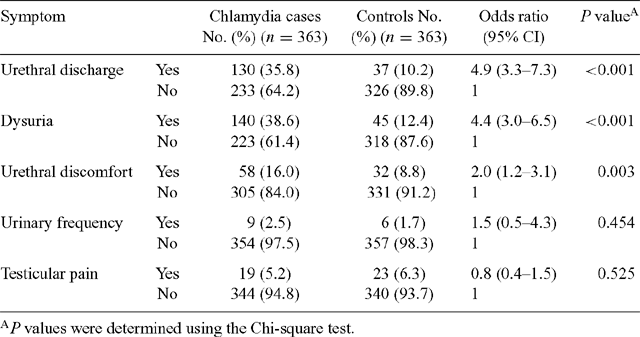Reply
Marcus Chen A B C and Basil Donovan A BA Sydney Sexual Health Centre, Sydney Hospital, GPO Box 1614, Sydney, NSW 2001, Australia.
B School of Public Health, University of Sydney.
C Author for correspondence; email: chenm@sesahs.nsw.gov.au
Sexual Health 1(3) 188-188 https://doi.org/10.1071/SH04036
Submitted: 30 August 2004 Published: 23 September 2004
Bradshaw et al. question the value of a urethral smear in the management of symptomatic non-gonococcal urethritis (NGU). They conclude that risk factors, together with symptoms, may be better guides to treatment.1,2 As the clinical severity of chlamydial urethritis varies between asymptomatic and symptomatic infection, it is to be expected that any ‘cut-off’ in polymorph count for diagnostic purposes is necessarily arbitrary.2 However the distinction between symptomatic and asymptomatic urethritis may be equally grey.
In a case control study, we examined genital symptoms reported by chlamydia-infected men attending our centre (Table 1). The investigator was blinded to the diagnosis of the 363 men with Chlamydia trachomatis diagnosed by urine polymerase chain reaction and 363 negative controls. It’s worth noting that the presence or absence of such symptoms is not always clear-cut. In eight of the cases, there was uncertainty on the part of the clinician (or a discrepancy between the clinician and triage nurse) over whether symptoms were present or not.

|
Although we have similar reservations about the indiscriminate use of microscopy of the urethral smear, it may be premature to do away with this test altogether. Many men present with atypical urethral symptoms of indeterminate significance and a degree of reassurance may be provided to the majority with a ‘negative’ smear. To those men with a ‘positive’ (≥ 5 polymorphs) smear, atypical symptoms, and a negative test for C. trachomatis we may have imparted a harmful result, but at least any harm will be minimised if we generally limit the intervention of microscopy to men with symptoms.3 Until the role and clinical spectrum of other pathogens responsible for non-chlamydial NGU becomes clearer, and reliable tests for these become widely accepted, microscopy of the urethral smear (as crude a tool as it is) may be the best we have to sort out men with equivocal symptoms.
[1] Bradshaw CS, Read TR, Fairley CK. The role of the urethral gram stain in non-gonococcal urethritis. Sex Health (in press).;

[2] Haddow LJ, Bunn A, Copas AJ, Gilson R, Prince M, Ridgway M, et al. Polymorph count for predicting non-gonococcal urethral infection: a model using Chlamydia trachomatis diagnosed by ligase chain reaction. Sex Transm Infect 2004; 80 198–200.
| Crossref | GoogleScholarGoogle Scholar | PubMed |

[3] Donovan B. Asymptomatic non-chlamydial non-gonococcal urethritis: an iatrogenic disease? (editorial). Sex Health 2004; 1 65–7.



